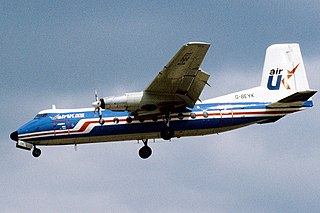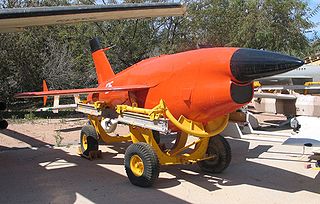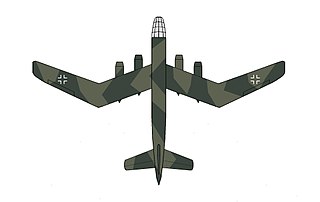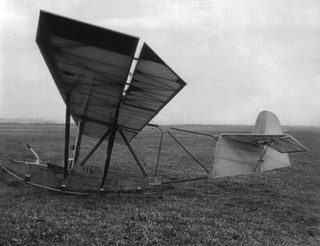
The IAI Westwind is a business jet initially produced by Aero Commander as the 1121 Jet Commander. Powered by twin GE CJ610 turbojets, it first flew on January 27, 1963, and received its type certification on November 4, 1964, before the first delivery. The program was bought by Israel Aircraft Industries (IAI) in 1968, which stretched it slightly into the 1123 Westwind, and then re-engined it with Garrett TFE731 turbofans into the 1124 Westwind. The 16,800–23,500 lb (7.6–10.7 t) MTOW aircraft can carry up to 8 or 10 passengers, and 442 were produced until 1987.

The BQM-74 Chukar is a series of aerial target drones produced by Northrop. The Chukar has gone through three major revisions, including the initial MQM-74A Chukar I, the MQM-74C Chukar II, and the BQM-74C Chukar III. They are recoverable, remote controlled, subsonic aerial target, capable of speeds up to Mach 0.86 and altitudes from 30 to 40,000 ft.

The Handley Page Dart Herald is a 1950s British turboprop passenger aircraft.

The Ape was a British biplane experimental aeroplane built by Armstrong Whitworth Aircraft in the early 1920s and first flown on 5 January 1926 to "answer all the questions of aerodynamics."

The Ryan Firebee is a series of target drones developed by the Ryan Aeronautical Company beginning in 1951. It was one of the first jet-propelled drones, and remains one of the most widely used target drones ever built.
The Sukhoi Su-10 or Izdeliye Ye was a Soviet turbojet-powered bomber aircraft built shortly after World War II.

The CAP-4 Paulistinha was a military and civilian trainer aircraft built in Brazil during the 1930s and 1940s. It was originally developed by Empresa Aeronáutica Ypiranga (EAY) as an unlicensed copy of the Taylor Cub powered by a Salmson 9Ad radial engine. It featured a high strut-braced wing, two enclosed tandem seats, and a steel-tube fuselage with fabric covering. Its tailwheel undercarriage was not retractable.
The Teledyne Ryan BQM-145 Peregrine is a reconnaissance unmanned aerial vehicle (UAV) developed in the United States in the 1990s as a joint U.S. Navy/Marine Corps and Air Force "Medium Range UAV" program, with the Navy developing the airframe and the Air Force providing the payload. The BQM-145A was designed to precede airstrike packages into a target area and relay reconnaissance information in real time.

The Brazilian automotive industry is coordinated by the Associação Nacional dos Fabricantes de Veículos Automotores (Anfavea), created in 1956, which includes automakers with factories in Brazil. Anfavea is part of the Organisation Internationale des Constructeurs d'Automobiles (OICA), based in Paris. In 2021, the annual production exceeded 2.2 million vehicles, the 8th largest in the world.
The Johansen CAJO 59 was a Danish twin-engined amphibious flying boat. Built in the late 1960s, it achieved certification but did not go into production.
The Akaflieg Darmstadt D-39 was a single-seat motor glider derived from the D-38 sailplane. Built in Germany in the late 1970s, it was not intended for production and only one was constructed.
The Smith X-99 Prop-Jet was a six-seat turboprop powered business aircraft designed in the United States in the 1980s. Only one was built.

The Blohm & Voss Bv P 188 was a long-range, heavy jet bomber design project by the Blohm & Voss aircraft manufacturing division during the last years of the Third Reich. It featured a novel W-wing planform with variable incidence.

The Albatros L.71 was a two-seat, single pusher engined biplane built in Germany in the 1920s.

The Potez-CAMS 161 was a large, French six-engined flying boat airliner, designed to operate on the North Atlantic routes that were opening up in the late 1930s. Its development was almost halted by World War II. Just one was built and partially tested before its destruction by Allied forces near the war's end.
The Curtiss-Reid Courier was designed in Canada in 1931 as a specialist, non-passenger carrying, mailplane capable of maintaining services in Canada's hard winters. The 1930s depression led to the end of government subsidised airmail contracts and only one prototype flew. It was lost in 1933 during preparations for a private, long distance flight.
The Waterman Flex-Wing was a four seat cabin aircraft designed to be easy for non-expert pilots to fly. Its principle safety features were based on a hinged wing providing controllable and interconnected dihedral and incidence. Two were built but the absence of funding in the difficult trading conditions of the Great Depression ended the project.
The SP-18 Onça also known as the IPAI-27 Jipe Voador, was a Brazilian single-seat, single engined experimental agricultural aircraft.

The Schubert P-1 is a sailplane produced in Brazil, designed by the aeronautical engineer Ekkehard Schubert.

The IPT-1 Gafanhoto, was a Brazilian single-seat, monoplane glider aircraft designed and manufactured for general flying.












